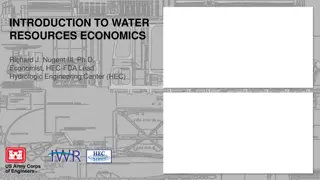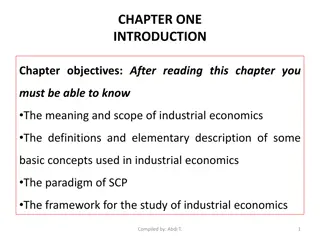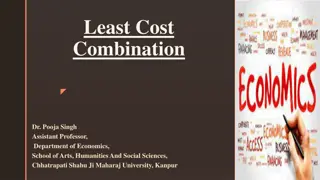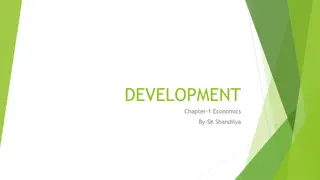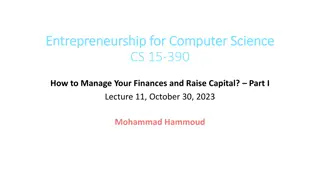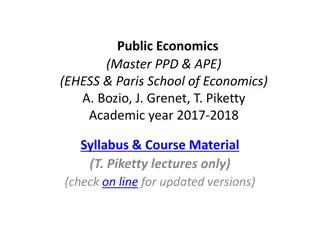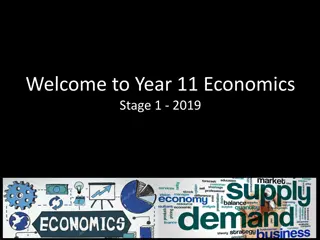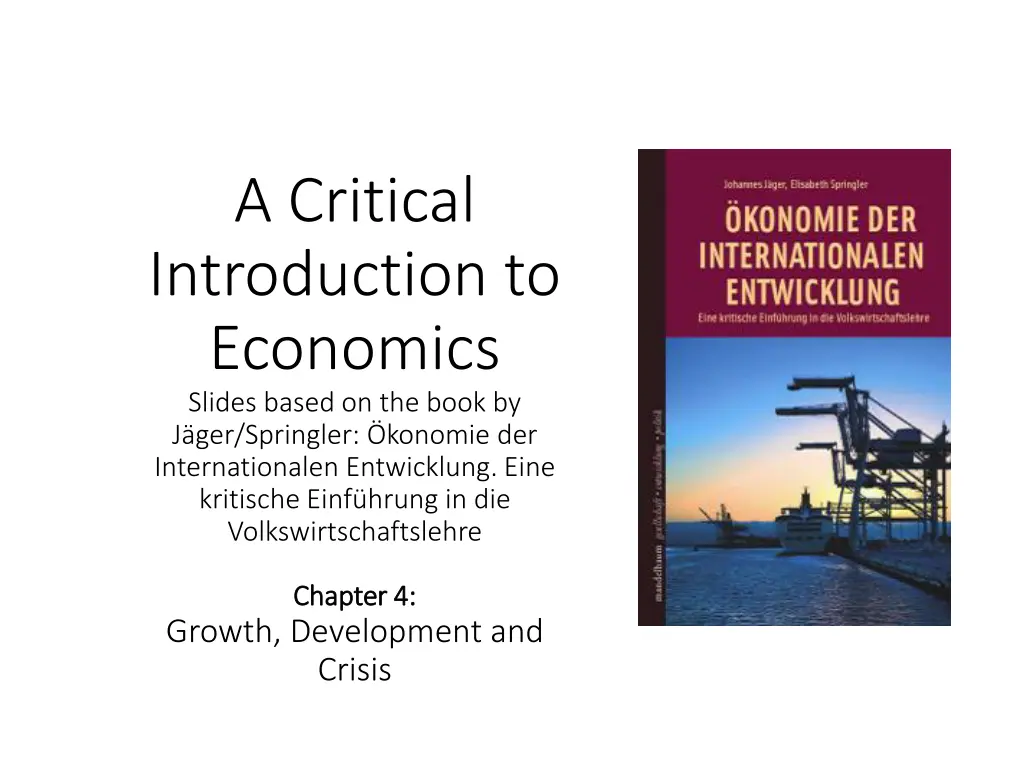
Understanding Growth, Development, and Crisis in Economics
Explore the concepts of income measurement, economic growth, and the distinction between growth and development in the field of economics. Delve into different paradigms such as Neoclassical economics, Keynesianism, and Political economy to understand global economic perspectives. Discover the significance of GDP, GNP, and factors influencing growth in a historical context.
Download Presentation

Please find below an Image/Link to download the presentation.
The content on the website is provided AS IS for your information and personal use only. It may not be sold, licensed, or shared on other websites without obtaining consent from the author. If you encounter any issues during the download, it is possible that the publisher has removed the file from their server.
You are allowed to download the files provided on this website for personal or commercial use, subject to the condition that they are used lawfully. All files are the property of their respective owners.
The content on the website is provided AS IS for your information and personal use only. It may not be sold, licensed, or shared on other websites without obtaining consent from the author.
E N D
Presentation Transcript
A Critical Introduction to Economics Slides based on the book by J ger/Springler: konomie der Internationalen Entwicklung. Eine kritische Einf hrung in die Volkswirtschaftslehre Chapter Chapter 4 4: : Growth, Development and Crisis
Growth, Development and Crisis (1) Measuring income and growth (2) Growth vs. development (3) Empirical overview of growth in a global historical perspective Growth, development and crisis in different paradigms: Neoclassical economics Keynesianism Political economy
(1) The Measurement of GDP and growth GDP (Gross Domestic Product) includes all items produced in the economy and sold legally on markets. It is: Sum of all value added in the economy (origin of GDP) Sum of all incomes in the economy (distribution of GDP) The market value of all final goods and services produced within a country in a given period of time (expenditure of GDP): Y = C + I +G + (X - M) GDP per capita GNP (Gross National Product) Nominal / real GDP and nominal / real economic growth
(2) Growth vs. development Economic growth = good and desirable vs. Economic growth can be problematic development Eurocentric idea of progress favours some societal interests /life styles over others Economic growth economic growth (growth for whom?) Problem of limited global resources
(3) Growth in a global historical perspective
Relative GDP per capita in world regions compared Relative GDP per Capita 6 Europe (12) 5 USA 4 AUS, CAN, NEZ 3 Latin America 2 Africa 1 Asia (w.o. Japan) 0 Average 1820 1870 1913 1950 1973 1998
4.1.1 Neoclassical Neoclassical economics economics: general approach Long-run market equilibrium, stability Saving is important for investment (capital goods) Quantity of Labour and productivity is important for growth Production function: Y = F(C,L)
4.1.2 Key-concepts in neoclassical economics (1) Traditional approaches to explain long-run growth Growth because increasing input factors and productivity (based on exogenous technology) convergence
4.1.2 Key-concepts in neoclassical economics (2) New approaches to explain long-run growth (new / endogenous growth theory) Diminishing returns Growth differences because of different use of technology and differences in human capital convergence and divergence possible
4.1.2 Key-concepts in neoclassical economics (3) The analysis of short term economic fluctuations AS-AD Model, based on monopolistic competition Short deviation from equilibrium possible tendency towards natural output Yn
4.1.3 Implications for economic policy Traditional growth theory: Markets do well New growth theory: Improve technological development Investment in human capital Increasing/stabilizing short term growth Structural reforms (deregulating labour and goods markets)
4.2.1 Keynesianism Keynesianism: general approach No growth equilibrium but path dependency Business cycle fluctuations are endogenous Investment as the key to growth and fluctuations Critique of the neoclassical assumption of homogenous capital
4.2.2 Key-concepts in Keynesianism The Keynesian growth model Actual rate of growth Natural rate of growth (that leads to full employment) Desired rate of growth (maximal utilization of stock of capital) Disequilibrium at the goods market difference between actual, natural and desired rate of growth Verdoorn s law (growth of output growth of productivity) Hyman Minsky s explanation of crisis
(1) Hyman Minskys explanation of crisis (1)
(2) Hyman Minskys explanation of crisis (2)
4.2.3 Implications for economic policy Avoid Financial Crisis Big Government /Functional Finance Labour market intervention: employer of the last resort Discretionary monetary policy (see chapter 6) Lender of last resort Large public sector and financial sector regulation
4.3.1 Political Economy Political Economy: general approach Imperative to accumulate dynamic capitalist development Contradictions of capitalist mode of production cyclical crisis structural crisis (overaccumulation, overproduction, profit squeeze, tendency of the profit rate to fall) Economic growth is a contested goal (accumulation by dispossession) Consumption fetishism vs. the good life for all
4.3.2 Key-concepts in Political Economy (1) Regulation theory to analyse growth and crisis Why are there periods of dynamic and stable growth despite the contradicitons in capitalism? (2) Historical growth regimes
(1) Regulation theory to analyse growth and crisis
(2) Historical growth regimes Fordist growth regime (1945-1970) productive, intensive, intraverted Crisis Finance-led growth regime (1980-2007) fictitious, extensive, extraverted Crisis (2008-)
4.3.3 Implications for economic policy Goals regarding economic growth Overcome capitalist mode of production (in the long run) Stabilize a more favourable mode of capitalist production (radical reformism): Coherence between accumulation and regulation De-commodification Societal discussion about desired forms of growth instead of growth fetishism (good life for all) Determinants for growth policies Class struggle within the context of specific modes of production (more open in periods of structural crisis) Effect of growth policies (changing aspects of structural forms) on growth depends on the specific context

